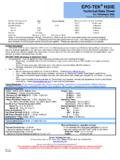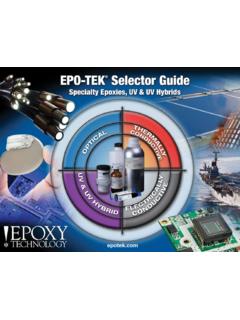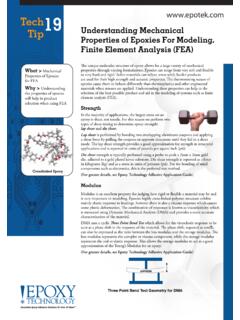Transcription of Viscosity and Thixotropic Index - EPO-TEK
1 TipViscosity and Thixotropic Index3 Viscosity and Thixotropic Index (TI) are common terminology used to describe the rheology of an epoxy. They both play a large role on how a product will perform for a particular is a measurement of a fluid s resistance to flow and is measured in Poise or more commonly centipoise (cPs). One cPs is equal to the Viscosity of water. From this reference, all other viscosities can be derived. A product like honey would have a much higher Viscosity of approximately 10,000 cPs and would flow much slower out of a tipped glass than water. Here is a list of common materials and their viscosities:Approximate Viscosities of Common Materials(At Room Temperature 70 F)MaterialViscosity in CentipoiseWater 1 cpsMilk 3 cpsSAE 10 Motor Oil 85-140 cpsSAE 20 Motor Oil 140-420 cpsSAE 30 Motor Oil 420-650 cpsSAE 40 Motor Oil 650-900 cpsCastrol Oil 1,000 cpsKaro Syrup 5,000 cpsHoney 10,000 cpsChocolate 25,000 cpsKetchup 50,000 cpsMustard 70,000 cpsSour Cream 100,000 cpsPeanut Butter 250,000 cpsIf necessary, the Viscosity of a material can be decreased with an increase in temperature to better suit an application.
2 Typically, this drop is in an exponential fashion. What > Viscosity and Thixotropic IndexWhy > Viscosity and TI are important parameters to consider when choosing an epoxy. Epoxy Technology Inc. 2015 Epoxy Technology Inc. 14 Fortune Drive Billerica, MA 01821phone 978-667-3805 fax 978-663-9782 Data presented is provided only to be used as a guide. Properties listed are typical, average values, based on tests believed to be accurate. It is recommended that users perform a thorough evaluation for any application based on their specific requirements. Epoxy Technology makes no warranties (expressed or implied) and assumes no responsibility in connection with the use or inability to use these products. Please refer to the product data sheets and safety data sheets (SDS) for more detailed below graph shows how EPO-TEK 353ND will react when heated:Temp ( C) Viscosity (cPs)23315325225227214729172831785337373 573745409551636514370102 Another important parameter that was mentioned earlier is Thixotropic Index .
3 Thixotropic Index is a ratio of a material s Viscosity at two different speeds, generally different by a factor of ten. This value is indicative of a material s ability to hold its shape. A highly Thixotropic material will drop in Viscosity as agitation or shear stress is increased. Mayonnaise is a great example of this. It will hold its shape very well, but when a shear stress is applied, the material will easily Viscosity and Thixotropic Index are important to consider when choosing an epoxy for a specific application and dispense method. The Viscosity of the 353ND drops very quickly, and then levels out at increased temperatures. This is a great tech-nique if an epoxy performs well for a certain application, but the Viscosity is slightly high. It is important to note that by heating the mixture, this can accelerate the cure and reduce the pot life significantly. For other useful tips, contact our Tech Service Group: or
















